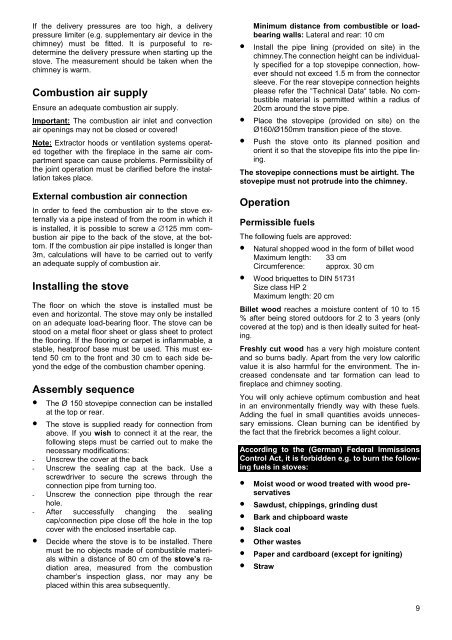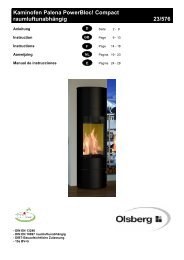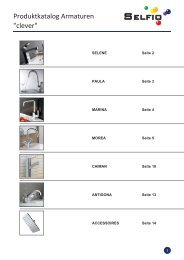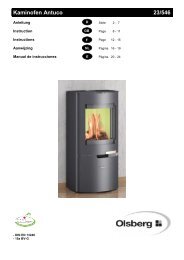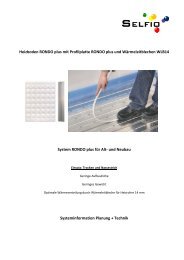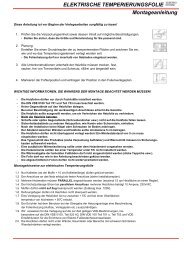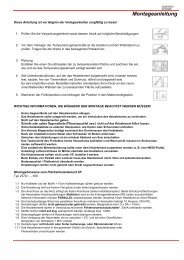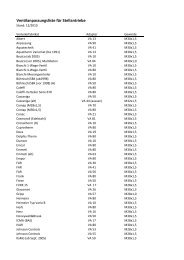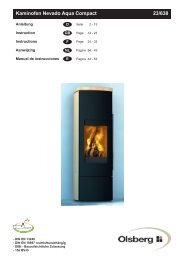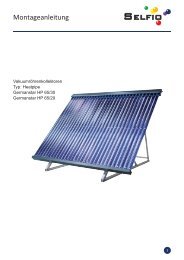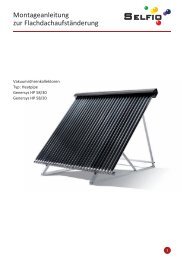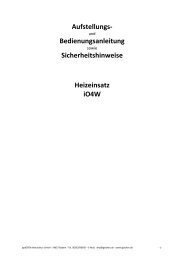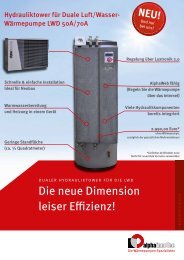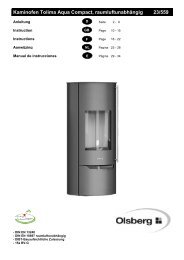Anleitung - Olsberg
Anleitung - Olsberg
Anleitung - Olsberg
Erfolgreiche ePaper selbst erstellen
Machen Sie aus Ihren PDF Publikationen ein blätterbares Flipbook mit unserer einzigartigen Google optimierten e-Paper Software.
If the delivery pressures are too high, a delivery<br />
pressure limiter (e.g. supplementary air device in the<br />
chimney) must be fitted. It is purposeful to redetermine<br />
the delivery pressure when starting up the<br />
stove. The measurement should be taken when the<br />
chimney is warm.<br />
Combustion air supply<br />
Ensure an adequate combustion air supply.<br />
Important: The combustion air inlet and convection<br />
air openings may not be closed or covered!<br />
Note: Extractor hoods or ventilation systems operated<br />
together with the fireplace in the same air compartment<br />
space can cause problems. Permissibility of<br />
the joint operation must be clarified before the installation<br />
takes place.<br />
External combustion air connection<br />
In order to feed the combustion air to the stove externally<br />
via a pipe instead of from the room in which it<br />
is installed, it is possible to screw a ∅125 mm combustion<br />
air pipe to the back of the stove, at the bottom.<br />
If the combustion air pipe installed is longer than<br />
3m, calculations will have to be carried out to verify<br />
an adequate supply of combustion air.<br />
Installing the stove<br />
The floor on which the stove is installed must be<br />
even and horizontal. The stove may only be installed<br />
on an adequate load-bearing floor. The stove can be<br />
stood on a metal floor sheet or glass sheet to protect<br />
the flooring. If the flooring or carpet is inflammable, a<br />
stable, heatproof base must be used. This must extend<br />
50 cm to the front and 30 cm to each side beyond<br />
the edge of the combustion chamber opening.<br />
Assembly sequence<br />
• The Ø 150 stovepipe connection can be installed<br />
at the top or rear.<br />
• The stove is supplied ready for connection from<br />
above. If you wish to connect it at the rear, the<br />
following steps must be carried out to make the<br />
necessary modifications:<br />
- Unscrew the cover at the back<br />
- Unscrew the sealing cap at the back. Use a<br />
screwdriver to secure the screws through the<br />
connection pipe from turning too.<br />
- Unscrew the connection pipe through the rear<br />
hole.<br />
- After successfully changing the sealing<br />
cap/connection pipe close off the hole in the top<br />
cover with the enclosed insertable cap.<br />
• Decide where the stove is to be installed. There<br />
must be no objects made of combustible materials<br />
within a distance of 80 cm of the stove’s radiation<br />
area, measured from the combustion<br />
chamber’s inspection glass, nor may any be<br />
placed within this area subsequently.<br />
Minimum distance from combustible or loadbearing<br />
walls: Lateral and rear: 10 cm<br />
• Install the pipe lining (provided on site) in the<br />
chimney.The connection height can be individually<br />
specified for a top stovepipe connection, however<br />
should not exceed 1.5 m from the connector<br />
sleeve. For the rear stovepipe connection heights<br />
please refer the “Technical Data“ table. No combustible<br />
material is permitted within a radius of<br />
20cm around the stove pipe.<br />
• Place the stovepipe (provided on site) on the<br />
Ø160/Ø150mm transition piece of the stove.<br />
• Push the stove onto its planned position and<br />
orient it so that the stovepipe fits into the pipe lining.<br />
The stovepipe connections must be airtight. The<br />
stovepipe must not protrude into the chimney.<br />
Operation<br />
Permissible fuels<br />
The following fuels are approved:<br />
• Natural shopped wood in the form of billet wood<br />
Maximum length: 33 cm<br />
Circumference: approx. 30 cm<br />
• Wood briquettes to DIN 51731<br />
Size class HP 2<br />
Maximum length: 20 cm<br />
Billet wood reaches a moisture content of 10 to 15<br />
% after being stored outdoors for 2 to 3 years (only<br />
covered at the top) and is then ideally suited for heating.<br />
Freshly cut wood has a very high moisture content<br />
and so burns badly. Apart from the very low calorific<br />
value it is also harmful for the environment. The increased<br />
condensate and tar formation can lead to<br />
fireplace and chimney sooting.<br />
You will only achieve optimum combustion and heat<br />
in an environmentally friendly way with these fuels.<br />
Adding the fuel in small quantities avoids unnecessary<br />
emissions. Clean burning can be identified by<br />
the fact that the firebrick becomes a light colour.<br />
According to the (German) Federal Immissions<br />
Control Act, it is forbidden e.g. to burn the following<br />
fuels in stoves:<br />
• Moist wood or wood treated with wood preservatives<br />
• Sawdust, chippings, grinding dust<br />
• Bark and chipboard waste<br />
• Slack coal<br />
• Other wastes<br />
• Paper and cardboard (except for igniting)<br />
• Straw<br />
9


